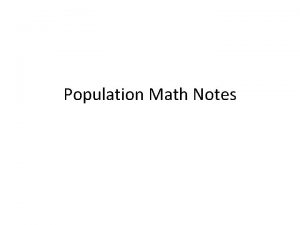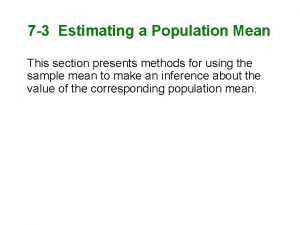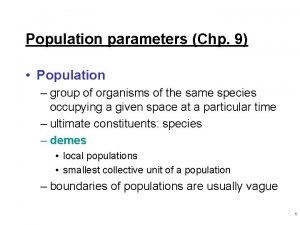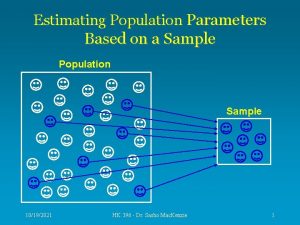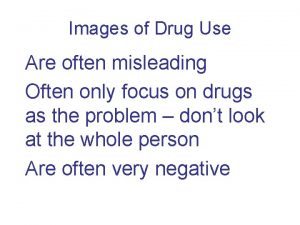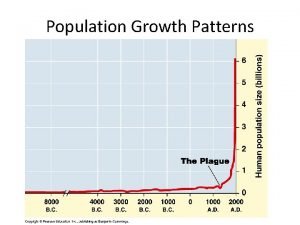Population Parameters Often we want to find parameters





















- Slides: 21

Population Parameters • Often we want to find parameters for an entire population – But it would not be practical • So we calculate an estimate from a sample – Calculate the mean and standard deviation of the sample – Call it good enough – Point estimate • But, how do we know the sample mean is a good enough estimate for the population mean?

Interval Estimate • Instead of a single-value estimate …. • Our estimate is a range: – Called the interval estimate (or confidence interval) – Surrounds the point estimate Point estimate Interval estimate

Interval Estimate • The point estimate is at the center of the interval estimate • There is a very high probability that the actual population parameter is within the interval estimate – We choose the “very high probability” • There is a slight probability that the population paramrter is outside the interval • The calculation of the interval estimate is based on: – the point estimates, – sample size, and – our definition of “very high probability”

Finding the Interval Estimate • The distance from the point estimate to confidence interval’s maximum and minimum is the margin of error. – It is based in the degree of confidence, sample standard deviation and sample size Point estimate Interval estimate

Degree of Confidence • The degree of confidence – Is the percent of all possible sample means that we want to be contained in our interval estimate. – Is the probability that the interval estimate actually contains the population parameter Sample means

Degree of Confidence and Critical value • From the degree of confidence we get the critical value: the z score that separates the degree of confidence from the rest of the distribution Sample means Degree of Critical confidence value 90% 1. 645 95% 99% 1. 96 2. 575

Margin of Error • From the critical value, standard deviation and critical value we get the margin of error • Finally…Confidence interval (x – E, x + E)

Summary (Large Sample Sizes) Degree of confidence Critical value (from the z table) Sample standard deviation Sample size Sample mean Margin of error Interval estimate

Example: Text Book Prices • We want to estimate the average text book price • From a sample size of N books: • Mean is 65. 12, • Standard deviation is 23. 08 • Degree of confidence is 95% • We want to estimate average math SAT scor • From a sample of 45 students: • Mean is 510 • Standard deviation is 90 • Degree of confidence:

Text Books Degree of confidence Critical value (from the z table) Sample standard deviation Sample size Margin of error Sample mean Interval estimate

SAT scores Degree of confidence Critical value (from the z table) Sample standard deviation Sample size Margin of error Sample mean Interval estimate

Your Turn • • • The average height of 100 female seniors is 66”. The standard deviation is 4” Degree of confidence: Point estimate: Interval estimate:

Summary (Large Sample Sizes) Degree of confidence Critical value (from the z table) Sample standard deviation Sample size Margin of error Sample mean Interval estimate

More on the Margin of error • Smaller margin of errors are better • Margin of error is directly related to degree of confidence and standard deviation – E. g. , the larger the standard deviation, the larger the margin of error • Margin of error is inversely related to sample size – E. g. , the larger the sample size, the smaller the margin of error

Homework • 1. 2. 3. 4. Calculate the mean and margin of error from these interval estimates (100, 124) (0. 56, 0. 7) (1256, 1297) (10. 5, 10. 6) • 5. 6. 7. 8. Calculate the interval estimate from these mean and margins of error X-bar = 59, E = 5 X-bar = 4. 8, E = 1. 2 X-bar = 145, E = 11. 5 X-bar = 10. 5, E = 1. 05

More Homework 9. Find the margin of error and interval estimate for the following point estimates X-bar s n Degree of E confidence 13. 6 1. 3 35 90% 235 1034 101 0. 321 0. 015 25693 2000 66 41 120 30 95% 99% 95% Interval

Still More Homework • A recent poll of 50 students’ average financial aid awards was $12000 with a standard deviation of $4500 10. What is the margin of error? 11. What is the interval estimate? 12. If we poll an additional 60 students what would the margin of error be? 13. Is it worth the extra effort to poll the 60 students?

Even More Homework • The mean drive thru service times at 52 Burger Kings was 181. 3 seconds (standard deviation was 82. 2) • The mean drive thru service times at 95 Golden Arches was 127. 8 seconds (standard deviation was 60. 6) 1. Calculate an interval estimate for both restaraunts 2. Compare the two interval estimates and draw a conclusion

Basis • Remember that the Central Limit Theorem says the sample means from a population are normally distributed Probability Sample means • All statistics we can calculate from every possible sample are themselves normally distributed.

Homework Answers 1. 2. 3. 4. 5. 6. 7. 8. 124, 12 0. 63, 0. 07 1276. 5, 20. 5 10. 55, 0. 05 (54, 64) (3. 6, 6. 0) (133. 5, 156. 5) (9. 45, 11. 53

More Homework Answers • If we assume a 95% degreee of confidence…
 Always usually often sometimes rarely never
Always usually often sometimes rarely never Exponential growth would be represented by a ____ curve
Exponential growth would be represented by a ____ curve Population ecology section 1 population dynamics answer key
Population ecology section 1 population dynamics answer key Section 1 population dynamics
Section 1 population dynamics Population ecology section 1 population dynamics
Population ecology section 1 population dynamics Population ecology chapter 4 answers
Population ecology chapter 4 answers Population density formula
Population density formula How to calculate point estimate
How to calculate point estimate Want ad for president
Want ad for president I want a wife essay
I want a wife essay Needs vs wants examples
Needs vs wants examples Voegwoorde groepe
Voegwoorde groepe Morrie i want my money gif
Morrie i want my money gif The greatest want of the world
The greatest want of the world Two bit mathews
Two bit mathews The greatest want of the world
The greatest want of the world What happens in chapter 12 of the lightning thief
What happens in chapter 12 of the lightning thief Map of europe
Map of europe George and tamara (doesn't don't) want to see that movie
George and tamara (doesn't don't) want to see that movie Elements of spoken word poetry
Elements of spoken word poetry I want someone to love me passive voice
I want someone to love me passive voice Reported speech cambios
Reported speech cambios






